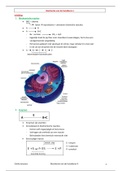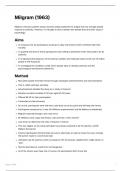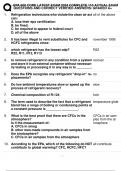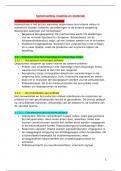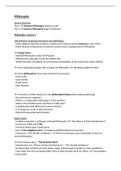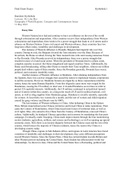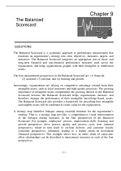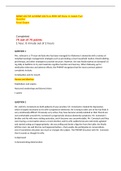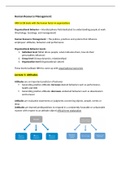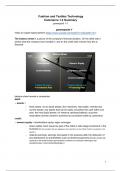Inleiding
1. Biochemische reacties
BIO – chemie
leven reproductie + uitvoeren chemische reacties
A B
A B+C
- Bv. sucrose CO2 + H2O
- Eigenlijk staat de pijl hier voor meerdere tussenstapjes, het is dus een
veralgemeende vergelijking
- Het proces gebeurt niet spontaan (in vitro), maar cellulair (in vivo) wel
- In de cel zijn enzymen die de reactie laten doorgaan
A B C D E
intermedaire biomoleculen
2. Enzymen
Enzymen zijn eiwitten
Ze katalyseren biochemische reacties
- Komen zelf ongewijzigd uit het proces
- Verhogen de snelheid van een reactie
- Beïnvloeden het chemisch evenwicht niet
Eenvoudige reactie:
E = enzym
S = substraat
P = product
Emily Janssens Biochemie van de huisdieren II 1
,3. Pathways
Pathway = aaneenschakeling van biochemische processen/reacties
Synoniemen:
- Pathway
- Metabole route
- Metabole baan
- Biochemische pathway
- Metabole pathway
Letters: stellen metabole intermediairen/ metabolieten voor
cijfers: stellen enzymen voor
Wat moet je kennen van pathways?
- Namen van de metabole intermediairen/metabolieten
- Namen van de enzymen
- Context
- Eventueel structuren (zie lijstje op BB)
Pathways zijn vaak vertakt
- Regulatie is belangrijk en naar gelang wat de cel nodig heeft
- De regulatie is vaak weefselspecifiek
Emily Janssens Biochemie van de huisdieren II 2
,4. Classificatie van pathways
Anabool = biosynthese processen
- eenvoudig complex
- kost energie
katabool = afbraakprocessen
- complex eenvoudig
- energie produceren
anabool en katabool zijn beide metabool
Er zijn 7 soorten pathways (in het energiemetabolisme)
katabolisme anabolisme
koolhydraten Glycolyse Gluconeogenese
Vetten (lipiden) Vetzuuroxidatie Vetzuursynthese
Aminozuren (eiwitten) Ureumcyclus aminozuursynthese
+ CITROENZUURCYCLUS = combinatie van alle vorige
Andere soorten pathways:
- Hormonen
- Neurotransmitters
- Zintuigen
- Celdeling en groei
- Embryonale ontwikkeling
- …
Emily Janssens Biochemie van de huisdieren II 3
,Enzymen
1. Inleiding
Sucrose CO2 + H2O
Geen spontane afbraak
lipiden CO2 + H2O
In vitro oxidatie van vetten gaat enkel in extreme situatie:
- Extreme pH
- Hoge temperatuur
- Corrosieve chemicaliën
In vivo oxidatie van vetten:
- Snel
- Binnen nauw pH-bereik
- Binnen nauw temperatuurbereik
- Gecontroleerd!
Sommige enzymen functioneren als eenvoudig eiwit
Andere enzymen hebben een bijkomende chemische component nodig
= Cofactor = bijkomend element dat soms nodig is om reactie te laten doorgaan
= bijkomend mechanisme voor controle van de reactie
Apo-enzym = enzym + substraat
Holo-enzym = enzym + substraat + cofactor
apo-enzym + cofactor = holo-enzym
Soorten cofactoren
1) Metaalion
2) Co-enzym
- Grote organische structuur
- Vaak vitaminederivaten
3) Prosthetische groep
- Grote organische structuur
- Permanent covalent (sterk) gebonden aan eiwit
Naamgeving enzymen
- Vaak het suffix –ase
- Woord of woorden die de activiteit beschrijven
- Naar de ontdekkers
- Grieks of Latijn
2. Werkingsmechanisme van enzymen
= katalytische site
= plaats waarom substraat bindt
Enzymen zijn katalysatoren
- Verhogen de snelheid van de reactie
- Beïnvloeden het chemisch evenwicht niet
Emily Janssens Biochemie van de huisdieren II 4
, Reacties beschrijven in termen van vrije energie (G)
Standaard vrije energie:
- In de chemie
ΔG°
Temperatuur 298K
Partiële gasdruk van de gassen 1 atm
Concentratie opgeloste stoffen 1M
- In de biochemie
ΔG’°
Temperatuur 298K
Partiële gasdruk van de gassen 1 atm
Concentratie opgeloste stoffen 1M
[H+] = 10-7 M pH 7
Activatie-energie moet overwonnen worden om S P
Enzymen verlagen de activatie-energie
Emily Janssens Biochemie van de huisdieren II 5

